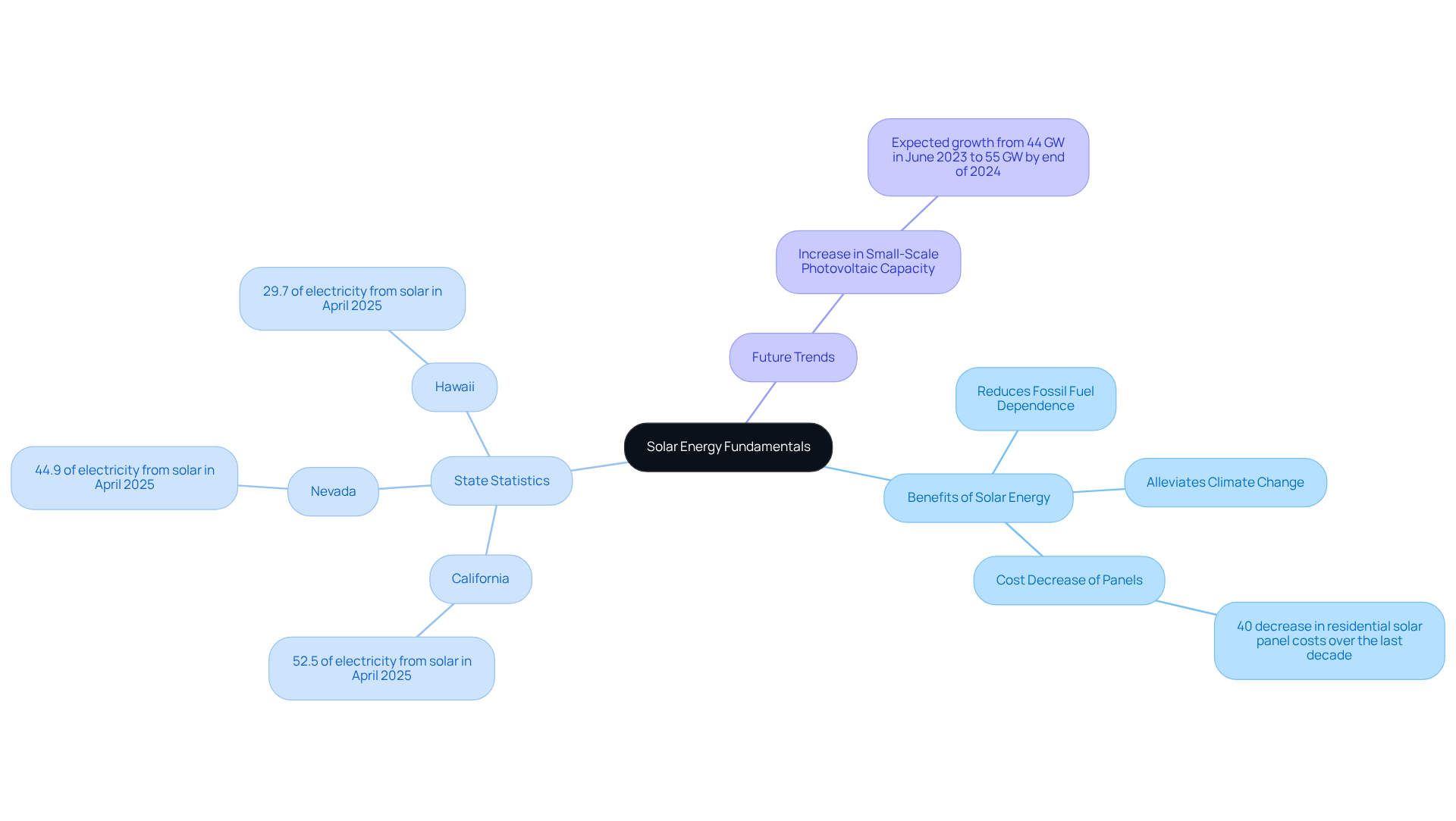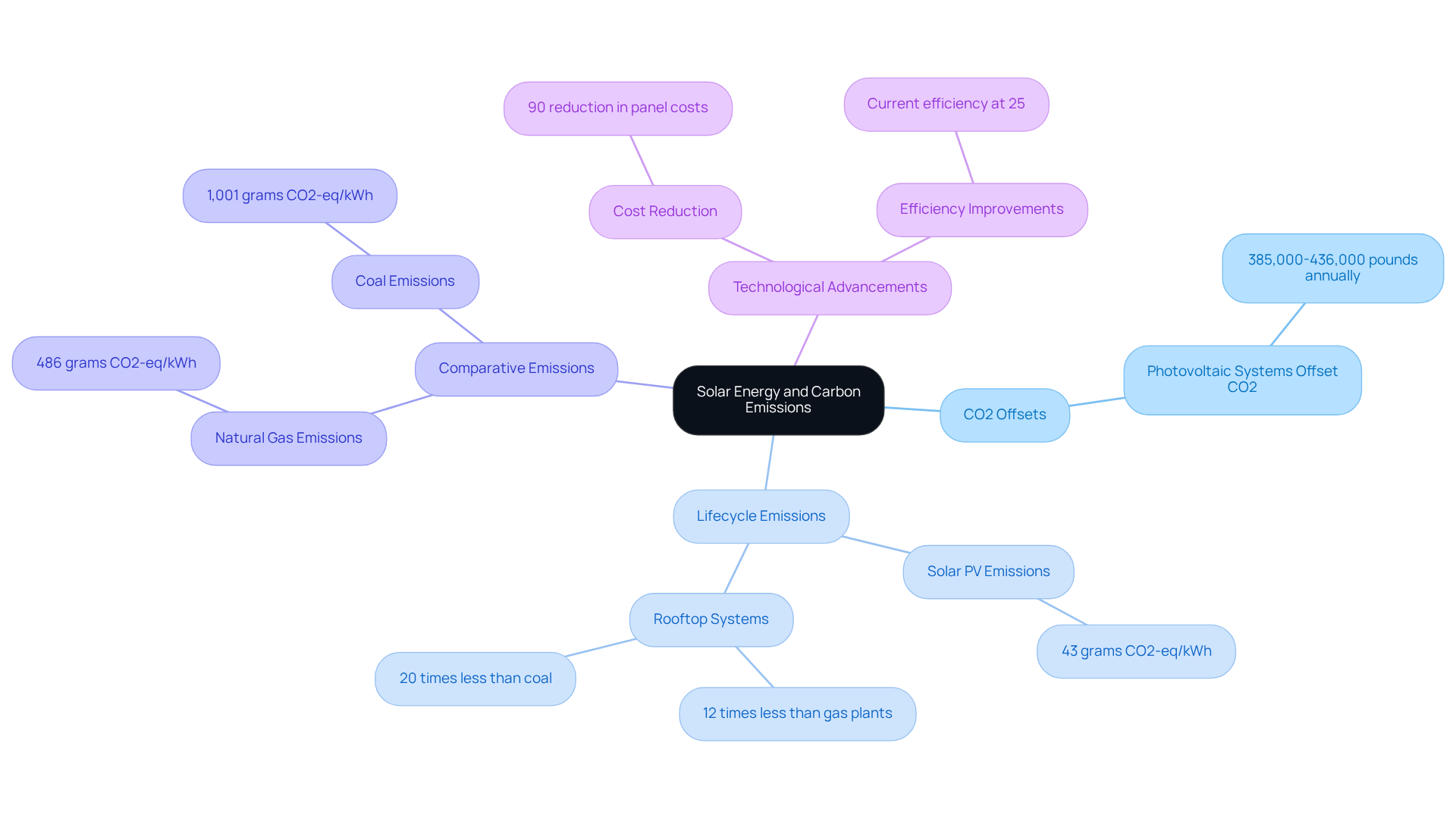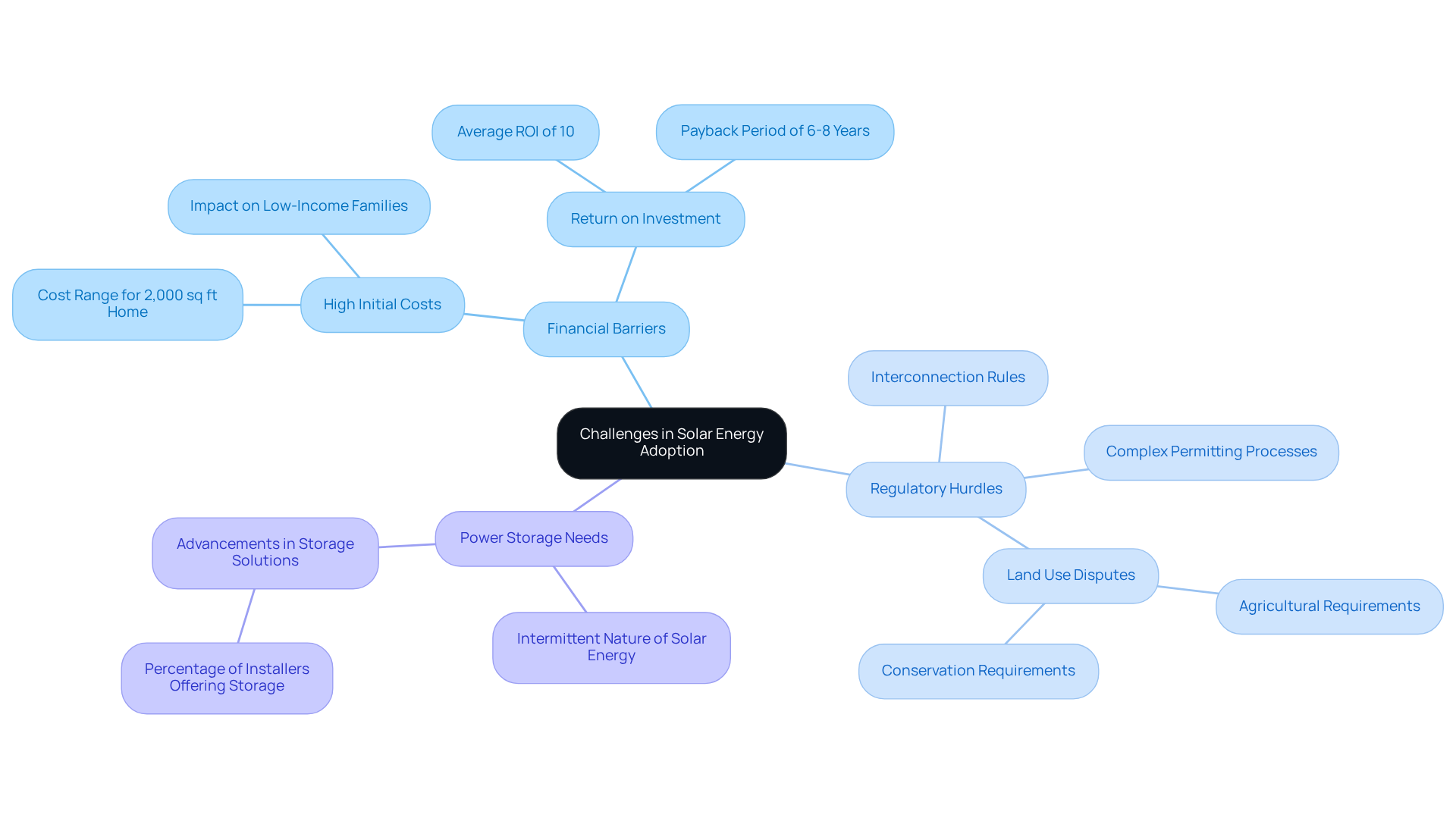Overview
This article highlights the critical strategies and insights essential for mitigating the environmental impact of solar energy. Solar power plays a pivotal role in significantly reducing our reliance on fossil fuels. This shift not only diminishes greenhouse gas emissions but also enhances air quality. Data supports this assertion, illustrating the substantial CO2 offsets achieved through photovoltaic systems. The implications of these findings are profound, showcasing the potential for solar energy to transform our energy landscape.
Introduction
The transition to solar energy signifies a crucial turning point in the pursuit of sustainable power, addressing not only the pressing energy demands but also the urgent issue of environmental degradation.
As advancements in solar technology unfold, its capacity to substantially lower carbon emissions and enhance air quality becomes increasingly clear, paving the way for a cleaner, healthier future.
Yet, the path to widespread solar adoption is laden with complexities—financial barriers, regulatory challenges, and the necessity for effective energy storage solutions present formidable obstacles.
How can stakeholders effectively navigate these hurdles to fully capitalize on the advantages of solar energy and drive significant reductions in environmental impact?
Explore Solar Energy Fundamentals and Environmental Context
Solar power captures sunlight using photovoltaic (PV) cells, transforming it into electricity. This renewable power source is essential for environmental impact reduction for solar, as it decreases dependence on fossil fuels, which are significant contributors to greenhouse gas emissions. As highlighted by ChooseEnergy.com, renewable power represented roughly 11% of the total electricity generated in the U.S. in April 2025, underscoring its increasing significance in the national power landscape.
Successful renewable energy projects across the country demonstrate the potential of this technology to reduce reliance on fossil fuels. For instance, California produced 52.5% of its electricity from sunlight in April 2025, affirming its status as the leading state in renewable power generation, according to ChooseEnergy.com. Nevada closely followed, with 44.9% of its electricity derived from photovoltaic sources, indicating a strong investment in renewable infrastructure. Hawaii also played a major role, generating 29.7% of its electricity from sunlight during the same period.
The incorporation of photovoltaic systems can occur in various settings, from home rooftops to large-scale energy farms. Each setting presents unique environmental considerations, including land use and ecosystem impacts. However, the primary advantage remains evident: renewable power not only supports environmental impact reduction for solar but also alleviates climate change and promotes a sustainable future. The expense of residential photovoltaic panels has decreased by 40% in the last ten years, further promoting uptake and lowering greenhouse gas emissions.
By grasping these fundamentals and recognizing the anticipated rise in small-scale photovoltaic capacity from 44 GW in June 2023 to 55 GW by the end of 2024, one can appreciate how this resource contributes to the environmental impact reduction for solar and addresses urgent environmental issues. Specialist perspectives, like those from renewable policy analyst Ben Zientara, emphasize the importance of sunlight power in the shift towards a cleaner energy landscape.

Analyze How Solar Energy Reduces Carbon Emissions
Solar power is pivotal in achieving environmental impact reduction for solar by replacing fossil fuel-based electricity generation and reducing carbon emissions. Studies reveal that an acre of photovoltaic systems plays a crucial role in environmental impact reduction for solar by offsetting between 385,000 and 436,000 pounds of CO2 annually, significantly exceeding the pollutant reductions achieved by traditional energy sources.
The lifecycle emissions of photovoltaic panels illustrate the environmental impact reduction for solar, as they emit only 43 grams of CO2-equivalents per kilowatt-hour, in stark contrast to coal's 1,001 grams and natural gas's 486 grams. Notably, the lifetime emissions of rooftop systems reflect significant environmental impact reduction for solar, being 12 times lower than those produced by gas plants.
This stark contrast underscores the importance of environmental impact reduction for solar energy as a cleaner alternative, essential for meeting climate goals and improving air quality. Furthermore, ongoing advancements in photovoltaic technology, exemplified by a 90% reduction in panel costs globally, enhance efficiency and contribute to environmental impact reduction for solar, solidifying its role as a critical component in the transition to sustainable energy.

Examine the Broader Environmental Benefits of Solar Energy
Solar power transcends the mere reduction of carbon emissions; its contributions are essential for environmental impact reduction for solar and enhancing environmental quality across multiple dimensions. By replacing fossil fuels, photovoltaic power systems play a significant role in environmental impact reduction for solar by effectively eliminating harmful pollutants, which leads to improved air quality. For instance, transitioning to renewable sources can reduce air contaminants by up to 90%, facilitating the development of healthier communities. Additionally, photovoltaic installations typically consume significantly less water than traditional power plants, a critical factor in regions facing water scarcity. In fact, photovoltaic power utilizes approximately 90% less water than conventional energy sources, establishing it as a sustainable option in arid areas.
Moreover, the integration of agricultural practices with solar energy, known as agrivoltaics, allows for dual land utilization. This innovative strategy not only optimizes land efficiency but also promotes biodiversity by creating habitats for various species. By cultivating crops alongside photovoltaic panels, stakeholders can enhance food production while generating clean energy. Furthermore, U.S. homeowners benefit financially, saving an average of $1,500 annually through photovoltaic installations, underscoring the economic advantages of this renewable resource.
These extensive benefits illuminate the profound positive impact of renewable energy sources on the environment, highlighting the importance of environmental impact reduction for solar in promoting sustainability and resilience within power systems. As Al Gore aptly stated, "It is your time to seize this issue; it is our time to rise again to secure our future." This ethical responsibility underscores the urgency of adopting renewable energy solutions, which not only protect our planet but also stimulate economic growth and job creation.

Identify Challenges and Considerations in Solar Energy Adoption
The adoption of solar energy, despite its promise, faces several significant challenges. High initial expenses remain a primary obstacle, particularly for low-income families. The typical cost of a photovoltaic system for a 2,000-square-foot residence ranges from $17,900 to $22,100 before tax incentives. This financial barrier can deter potential investors, as many households struggle to cover the upfront costs associated with renewable energy installations. Industry leaders emphasize that addressing these financial challenges is crucial for enhancing access to renewable power.
Regulatory hurdles also critically impede project timelines. Complex permitting processes and interconnection rules can significantly delay the deployment of energy projects. It is essential for stakeholders to advocate for streamlined regulations that facilitate quicker approvals. Additionally, land use disputes often arise when photovoltaic farms must navigate agricultural or conservation requirements. This situation necessitates meticulous planning and community involvement to balance power generation with land conservation.
Moreover, the intermittent nature of solar energy underscores the urgent need for advancements in power storage solutions. In 2024, 92% of residential installers reported providing storage system installations, reflecting a robust industry response to this challenge. Without reliable storage options, the efficiency of solar energy harnessing can be compromised, particularly during periods of reduced sunlight. By recognizing these challenges, stakeholders can devise targeted strategies to overcome barriers, ensuring that solar energy is effectively integrated into the energy mix and contributes to a sustainable future.

Conclusion
The exploration of solar energy underscores its vital role in mitigating environmental impacts and promoting sustainability. Harnessing sunlight enables solar power to significantly reduce reliance on fossil fuels and curtail greenhouse gas emissions, establishing it as an indispensable asset in the quest for a cleaner, healthier planet. The integration of photovoltaic systems across diverse settings not only enhances energy production but also tackles pressing environmental challenges, reinforcing the urgent need for widespread adoption of this renewable resource.
Key insights reveal that solar energy not only lowers carbon emissions but also improves air quality, conserves water, and supports biodiversity through innovative practices like agrivoltaics. Impressive statistics, such as the substantial reduction in lifecycle emissions compared to fossil fuels, highlight the effectiveness of solar power in achieving environmental goals. However, challenges like high initial costs and regulatory hurdles must be addressed to fully realize solar energy's potential.
As the urgency for sustainable energy solutions intensifies, the importance of embracing solar power becomes increasingly evident. Stakeholders must prioritize overcoming barriers to adoption, advocating for streamlined regulations, and investing in storage technologies. By taking these actions, the transition to solar energy can accelerate, paving the way for a more sustainable future that benefits both the environment and the economy. Embracing solar energy is not merely an option; it is a responsibility that can lead to transformative change for generations to come.
Frequently Asked Questions
What is solar power and how does it work?
Solar power captures sunlight using photovoltaic (PV) cells, transforming it into electricity.
Why is solar energy important for the environment?
Solar energy is essential for reducing environmental impact as it decreases dependence on fossil fuels, which are significant contributors to greenhouse gas emissions.
What percentage of electricity generated in the U.S. came from renewable sources in April 2025?
Renewable power represented roughly 11% of the total electricity generated in the U.S. in April 2025.
Which state produced the highest percentage of electricity from solar power in April 2025?
California produced 52.5% of its electricity from sunlight in April 2025, making it the leading state in renewable power generation.
What percentages of electricity did Nevada and Hawaii generate from solar power in April 2025?
Nevada generated 44.9% of its electricity from photovoltaic sources, while Hawaii generated 29.7% from sunlight during the same period.
Where can photovoltaic systems be installed?
Photovoltaic systems can be installed in various settings, including home rooftops and large-scale energy farms.
What are some environmental considerations associated with photovoltaic installations?
Environmental considerations include land use and ecosystem impacts, which vary depending on the installation setting.
How has the cost of residential photovoltaic panels changed in the last decade?
The expense of residential photovoltaic panels has decreased by 40% in the last ten years, promoting uptake and lowering greenhouse gas emissions.
What is the expected growth in small-scale photovoltaic capacity from June 2023 to the end of 2024?
Small-scale photovoltaic capacity is anticipated to rise from 44 GW in June 2023 to 55 GW by the end of 2024.
Who emphasizes the importance of solar power in the transition to cleaner energy?
Renewable policy analyst Ben Zientara emphasizes the importance of sunlight power in the shift towards a cleaner energy landscape.
List of Sources
- Explore Solar Energy Fundamentals and Environmental Context
- Today in Energy - U.S. Energy Information Administration (EIA) (https://eia.gov/todayinenergy/detail.php?id=61242)
- 2025 Solar Energy Statistics: Latest Industry Survey Data (https://solarreviews.com/blog/solarreviews-solar-industry-survey-key-statistics)
- Solar Energy by State July 2025 | Choose Energy (https://chooseenergy.com/solar-energy/solar-energy-production-by-state)
- 90+ Solar Energy Statistics: The Green Gold Rush (2025) - Enkonn Solar (https://enkonnsolar.com/solar-energy-statistics)
- Short-Term Energy Outlook - U.S. Energy Information Administration (EIA) (https://eia.gov/outlooks/steo/report/BTL/2023/09-smallscalesolar/article.php)
- Analyze How Solar Energy Reduces Carbon Emissions
- Solar Panel Statistics, Facts, and Trends of 2025 (https://greenmatch.co.uk/solar-energy/solar-pv-statistics)
- 90+ Solar Energy Statistics: The Green Gold Rush (2025) - Enkonn Solar (https://enkonnsolar.com/solar-energy-statistics)
- What is the Carbon Footprint of Solar Panels? (https://solar.com/learn/what-is-the-carbon-footprint-of-solar-panels)
- Is solar energy worse for the climate than burning fossil fuels? (https://skepticalscience.com/is-solar-energy-worse-for-the-climate-than-burning-fossil-fuels.htm)
- Solar Panels Reduce CO2 Emissions More Per Acre Than Trees — and Much More Than Corn Ethanol (https://news.climate.columbia.edu/2022/10/26/solar-panels-reduce-co2-emissions-more-per-acre-than-trees-and-much-more-than-corn-ethanol)
- Examine the Broader Environmental Benefits of Solar Energy
- 60 Quotes About the Future of Renewable Energy (https://deliberatedirections.com/renewable-energy-quotes)
- 20 Quotes To Get You Inspired For a Renewable Future - Solstice (https://solstice.us/solstice-blog/20-quotes-for-a-renewable-future)
- The Executive Headlines - Top business magazine & news headlines sources (https://executiveheadlines.com/erp/quotes-on-sustainable-energy)
- 90+ Solar Energy Statistics: The Green Gold Rush (2025) - Enkonn Solar (https://enkonnsolar.com/solar-energy-statistics)
- Quotes About Solar Power: 50 Picks to Light Up Your Life - Lumify Energy (https://lumifyenergy.com/blog/quotes-about-solar-power)
- Identify Challenges and Considerations in Solar Energy Adoption
- Top Solar Quotes (https://inventionsolar.com/solar-quotes)
- 60 Quotes About the Future of Renewable Energy (https://deliberatedirections.com/renewable-energy-quotes)
- 90+ Solar Energy Statistics: The Green Gold Rush (2025) - Enkonn Solar (https://enkonnsolar.com/solar-energy-statistics)
- 2025 Solar Energy Statistics: Latest Industry Survey Data (https://solarreviews.com/blog/solarreviews-solar-industry-survey-key-statistics)
- How Much Do Solar Panels Cost In 2025? (https://forbes.com/home-improvement/solar/cost-of-solar-panels)




